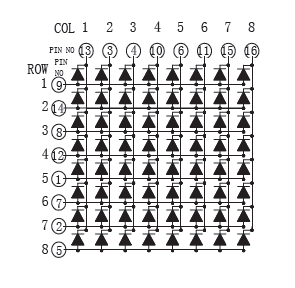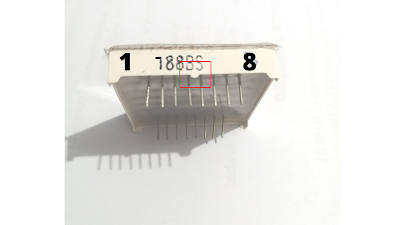
Shahbaz75sb
-
Posts
2 -
Joined
-
Last visited
Content Type
Profiles
Forums
Events
Posts posted by Shahbaz75sb
-
-
788bs Led Matrix Pinout
There are several types of led matrix displays available in the market. We can understand it in size and types, e.g. 5x7, 8x8, common anode, and common cathode type.But in this article, I will discuss 788bs as a common anode 8x8 red color matrix Modules. We use it in many electronics displaying items, e.g. electronics clocks. also for moving message displays, displaying games, etc.We use dot matrix display with an Arduino UNO board directly, sometimes in projects. But for some projects, we use a max7219 chip or 74hc595 for dot matrix driver as required in our projects.8x8 dot Matrix Pinout details
The dot-matrix modules most of the time comes in red color. It is very easy to attach with an Arduino board as compared to RGB led. If we look at a piece of the 8x8 dot matrix, it contains 16 pins in which 8 pins used for rows and 8 for columns out of 64 Led.
We start from Pin # 1 to pin # 8. Pin number 1 is R5 (Row-5) and Pin number 8 is R3 (Row-3) at the downside.
At the upper side From Pin 9 (Row-1) to Pin 16 (column-1) located. But a newbie always confuses and starts from zero, because we know the picture/diagram. often we get from some source, also we have to sort out which one +VE and -VE. might be an expert can understand from common cathode/anode type.But my concern about the person has a basic knowledge of electronics. Who try to make their own initial display projects like a clock or some more.Ok, let’s start if we have an 8x8 dot matrix and how do we know where pin 1 is? As in IC Chips near Pin 1, a dot mentioned at IC/Microcontroller Chip. But here, how do we know?At the led dot matrix, the manufacturer writes the tag or mark at pin 1 side, as shown in the figure. We can find it. And also a curve mentioned at pin number 1 side.Row = + Positive Supply
Column = - Negative SupplyThe testing power supply should be 1.5V DC required. it means only one battery cell enough or uses one 130 ohm resistance in series at a positive/negative side.After that attached led to the power supply. We found that the 8th column and 5th rows led become ON as Connection shown in the figure. How to connect the battery cell with a matrix display.Pin Test of led dot matrix
As shown in fig pin # 1 and pin # 16 got Energize and 8th Column and 5th-row led become ON. We should verify the Dot-matrix before using because if any led blows we can change.Programming with Arduino UNO
To run the 788bs, you need to check it with Arduino UNO. What material you need to perform a complete test.-
Arduino UNO Amazon
-
Battery (1.5V) only one
-
Jumper wires
The dot matrix display often used with the shift register 74HC595 led driver or max7219. most common in electronic Circuits, we operate it with a Microcontroller or Arduino platform, and even with Raspberry Pi. But in this circuit, you can test the matrix direct with an Arduino UNO board.Interface dot matrix with Arduino
First setting up the matrix circuit, as per the connection given in the picture diagram. start the Arduino IDE to program the Arduino UNO board. Arduino IDE is available at Arduino official site. For this circuit, it does not need resistance at all. Just connect wires as per given instruction.here you need two steps before starting a matrix connection with Arduino.as per the 788bs datasheet, matrix pins connection given.1- 8x8 led matrix code generator
This will help to generate code for your matrix. Just draw anything for the matrix, copy the code, and use it in your program. You can draw different symbols, shapes, or words.2- Add matrix library with Arduino Ide
First, add the 8x8 led dot matrix library in Arduino Ide. After that, the library manager in Arduino Ide will run the code. It will display in the matrix.
Connection Diagram 788bs matrix and Arduino UNO
Matrix Rows Pins # ------------ Arduino Uno Pins #Pin # 1 ---------- 2
2 ---------- 3
3 ---------- 4
4 ---------- 5
5 ---------- 6
6 ---------- 7
7 ---------- 8
8 ---------- 9
Matrix Column: Pins # ----------------- Arduino Uno Pins #Pin # 1 -------------10
2 ------------- 11
3 ------------- 12
4 ------------- 13
5 ------------- A1
6 ------------- A2
7 ------------- A3
8 ------------- A4 -







Arduino sensors modules for beginners
in Theory articles
Posted
Best Arduino sensors - for beginners electronics projects
What is Sensor?
Sensors and actuators widely used in Arduino projects. These sensors come with a kit or can be purchased separately. Some of them are compatible with Arduino Uno boards and also Raspberry Pi and other electronics modules. There are lots of Arduino sensors kits available in the market.
How many types of Arduino Sensors?
Analog temperature Sensors
KY 013 temperature sensor
Digital temperature module
Digital temperature Sensor
Digital temperature module
Temperature and Humidity module
Arduino IR sensor
Light Dependent Resistor(LDR)
Joystick Module
Metal Touch Sensor
Sound sensor
Arduino Laser sensor
Arduino optical switch
Passive buzzer sensor
Vibration sensor
Arduino Shock sensor
Arduino component kit